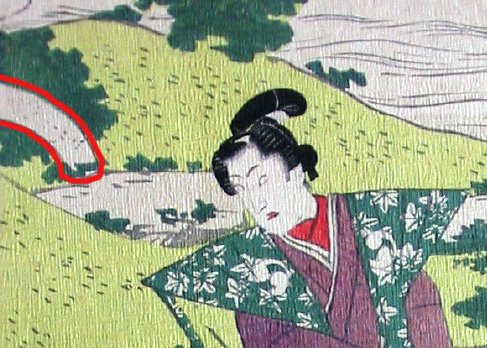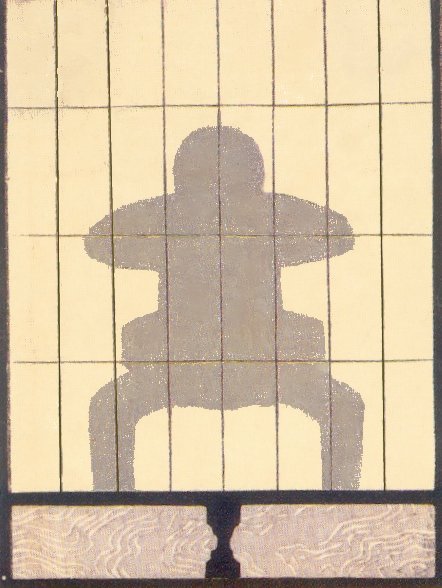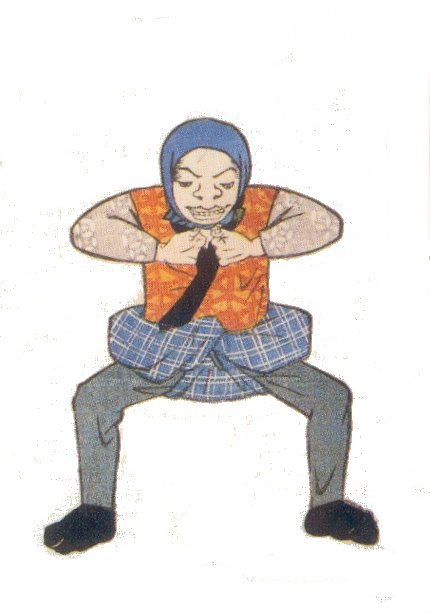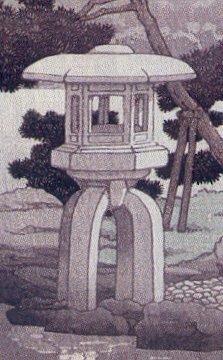
JAPANESE PRINTS
A MILLION QUESTIONS
TWO MILLION MYSTERIES
Ukiyo-e Prints浮世絵版画 |
| Port Townsend, Washington |
|
UTAGAWA KUNISADA 1786-1865 |
|
歌川国貞 |
|
うたがわくにさだ |
| Subject: Kanadehon Chūshingura |
| 仮名手本忠臣蔵 |
| かなでほん.ちゅうしんぐら |
|
Actor: Ichikawa Fuzō V |
|
市川傅? |
|
いちかわ.ふぞ |
|
Role: Ōboshi Rikiya (Ōboshi Rikiya is the son of Ōboshi Yuranosuke. There is another print by Kunisada created 45 years later (1854, 9th month) in which Rikiya is portrayed in almost exactly the same pose and costume - with slight differences, but the later image is set in an interior and naturally portrays a different actor. One copy of this later version is found in the Museum für angewandte Kunst in Vienna. Personally I find our example much more exciting and beautiful.) |
|
大ぼし力弥 |
|
Publisher: Unidentified |
|
Signed: Gototei Kunisada ga 五渡亭国貞画 |
|
Size: 13 3/4" x 9 1/2" |
|
Type: Chirimen (crepe print) |
|
Date: 1814, 4th Month (We had originally dated this print as circa 1825 based on information provided by a credible source. However, we recently found an example in the collection at Waseda University. They have established the precise date. Our print is in much better condition.) |
|
|
|
$320.00 SOLD! |
 |
||
|
This is certainly the right-hand panel of a diptych. It may be a part of a larger grouping, but so far I only know of one other print which can be paired with it. The first give away is the stone leg of a yukimi dōrō (雪見灯籠 or ゆきみ.どうろう) or snow viewing lantern. My suspicion was cinched when I ran across the left-hand panel in the wonderful collection at Waseda University which shows an onnagata either collapsed or kneeling on the ground.
Note the crude red outline of the stone leg of the yukimi dōrō in the detail from the print seen above.
Below are two details from a print by Hiroshige. The one on the right is a fellow imitating a yukimi dōrō while the one on the left is what you would see if you were looking at him silhouetted from outside casting a shadow on a shoji screen.
Above is a detail of a yukimi dōrō from a print by Hasui from 1938.
|
|
ONE OF THE THINGS I FIND MOST REMARKABLE ABOUT THIS PRINT
There must be a soft spot in my heart for crepe prints. Actually I like nearly all crepes be they fabrics, food or paper. Anyway, the reason I am particularly drawn to this one is its age. Most of the crepe prints which I have seen up until now were from the late 19th and early 20th centuries. Although I had heard that there were earlier examples I hadn't seen one until this print which predates by many decades the most common encountered ones. John Fiorillo notes on his web site that they were made as early as 1800. However, it wasn't just the age which drew me to this print. It was also its coloring which is remarkably well preserved. Fiorillo reproduces an illustration and description of a mechanical, wooden contraption that was used to create crepe prints. Print making was already incredibly labor intensive and creating a crepe example simply added greater effort to the whole process. A number of moistened sheets would be wrapped around a small, rounded wooden post and then pressed down into a finely grooved board. Then the sheets were moved slightly and the process was repeated. And then again. And then again and again and again until the whole sheet had become dented all over in what is a fairly uniform pattern. That explains two things: 1)Why the print would shrink down physically from its original size and 2) how it was able to maintain its image in an undistorted manner. Clearly this was nothing more than a marketing gimmick. Aesthetics aside the profit margin for most ordinary prints must have been fairly low on an average. This technique of creping or crinkling would surely cut into those earnings that much more. Perhaps that is why such prints are relatively rare and should be considered more as oddities than anything else - but for me wonderful oddities. |




 HOME
HOME